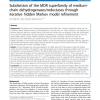BMCBI
2010
13 years 11 months ago
2010
Background: The investigation of plant genome structure and evolution requires comprehensive characterization of repetitive sequences that make up the majority of higher plant nuc...
BMCBI
2010
13 years 11 months ago
2010
Background: Sub-cellular structures interact in numerous direct and indirect ways in order to fulfill cellular functions. While direct molecular interactions crucially depend on s...
BMCBI
2010
13 years 11 months ago
2010
Background: Protein-protein interaction (PPI) plays essential roles in cellular functions. The cost, time and other limitations associated with the current experimental methods ha...
BMCBI
2010
13 years 11 months ago
2010
Background: The Medium-chain Dehydrogenases/Reductases (MDR) form a protein superfamily whose size and complexity defeats traditional means of subclassification; it currently has ...
BMCBI
2010
13 years 11 months ago
2010
Background: Immunoglobulin (IG or antibody) and the T-cell receptor (TR) are pivotal proteins in the immune system of higher organisms. In cancer immunotherapy, the immune respons...
BMCBI
2010
13 years 11 months ago
2010
Background: A growing demand for tools to assist the building and analysis of biological networks exists in systems biology. We argue that the use of a formal approach is relevant...
BMCBI
2010
13 years 11 months ago
2010
Background: Biomedical research is set to greatly benefit from the use of semantic web technologies in the design of computational infrastructure. However, beyond well defined res...
BMCBI
2010
13 years 11 months ago
2010
Background: Molecular interaction networks can be efficiently studied using network visualization software such as Cytoscape. The relevant nodes, edges and their attributes can be...
BMCBI
2010
13 years 11 months ago
2010
Background: While multiple alignment is the first step of usual classification schemes for biological sequences, alignment-free methods are being increasingly used as alternatives...
BMCBI
2010
13 years 11 months ago
2010
Background: Liquid chromatography-mass spectrometry (LC-MS) is one of the major techniques for the quantification of metabolites in complex biological samples. Peak modeling is on...


